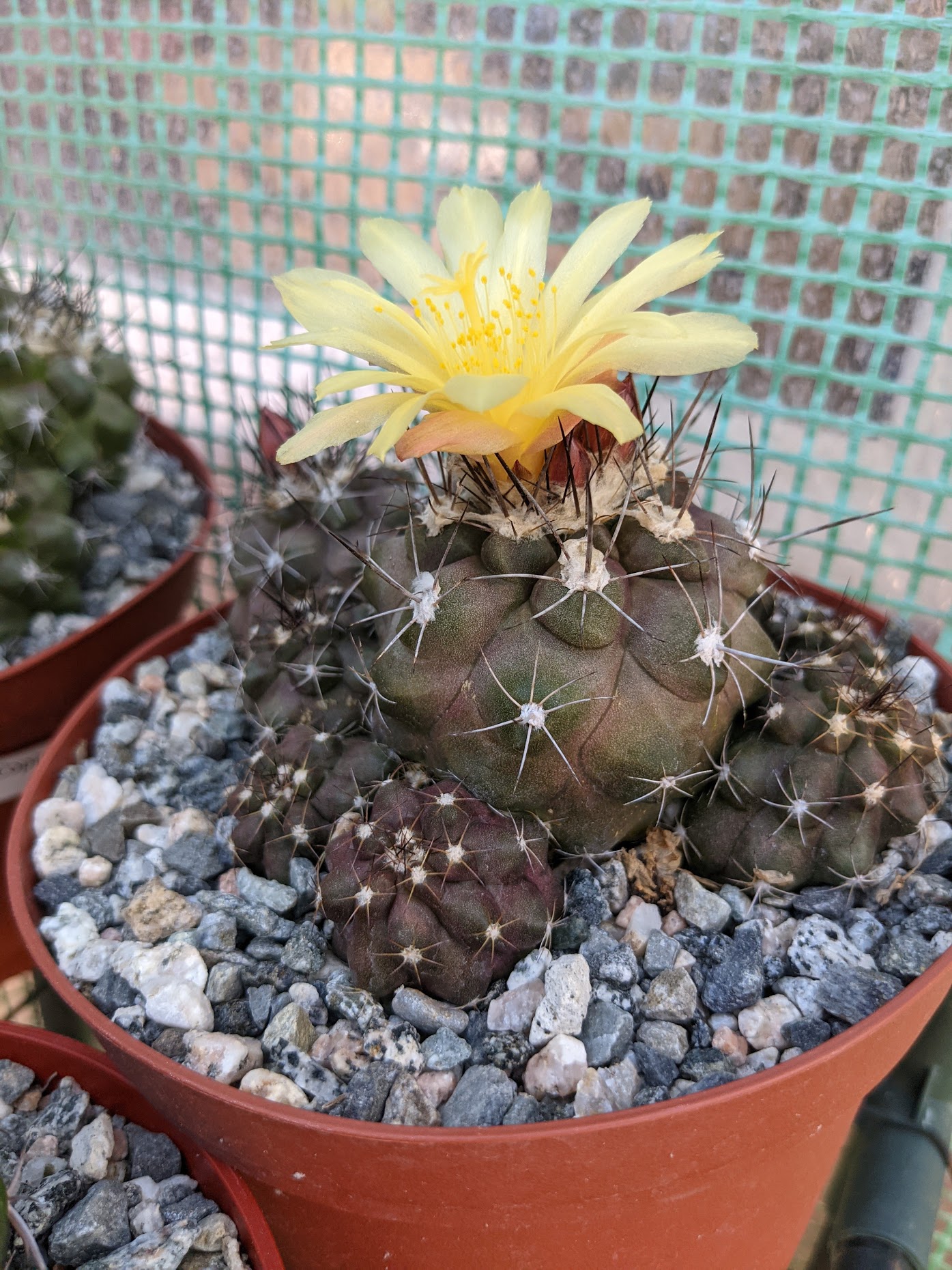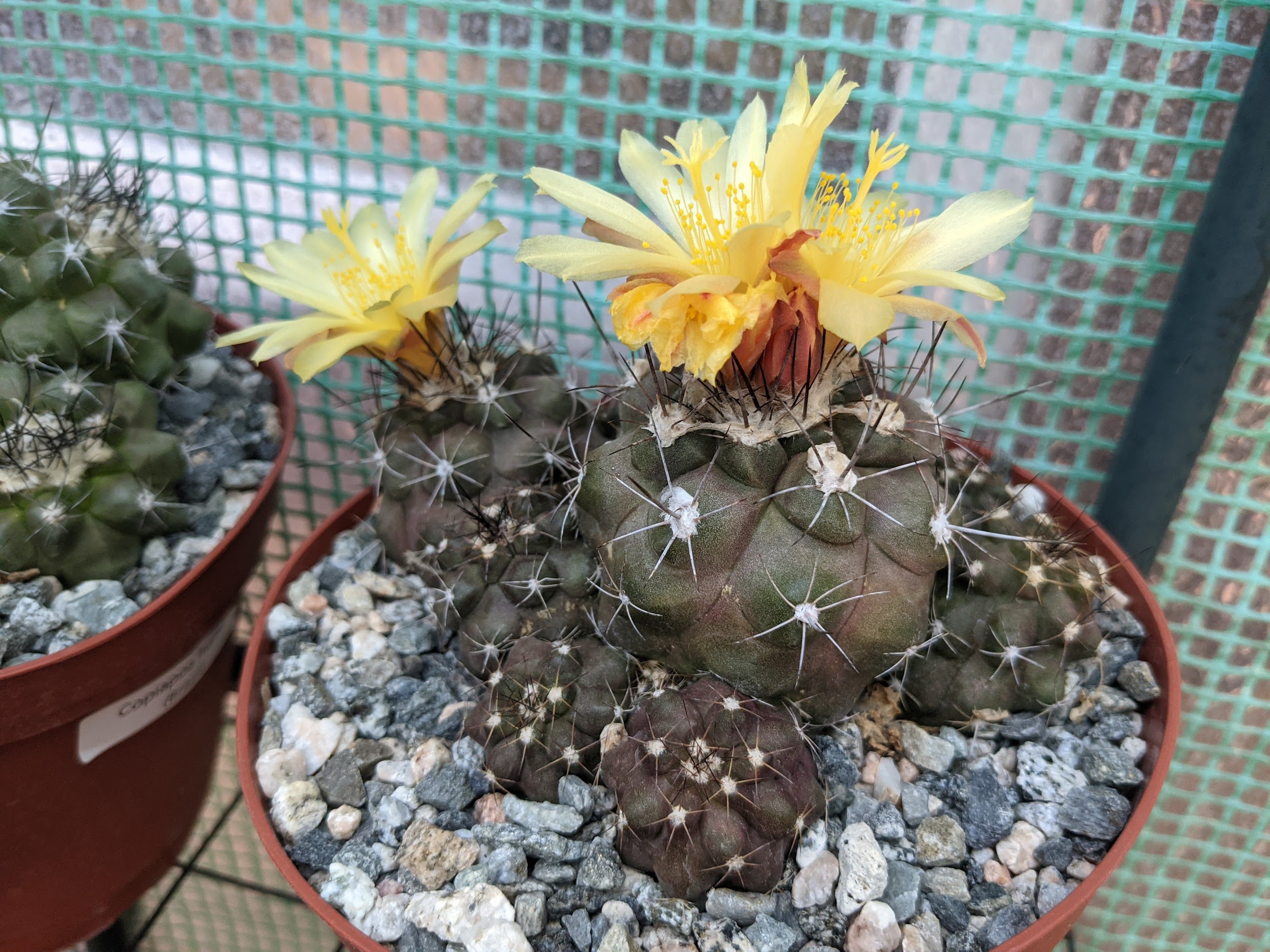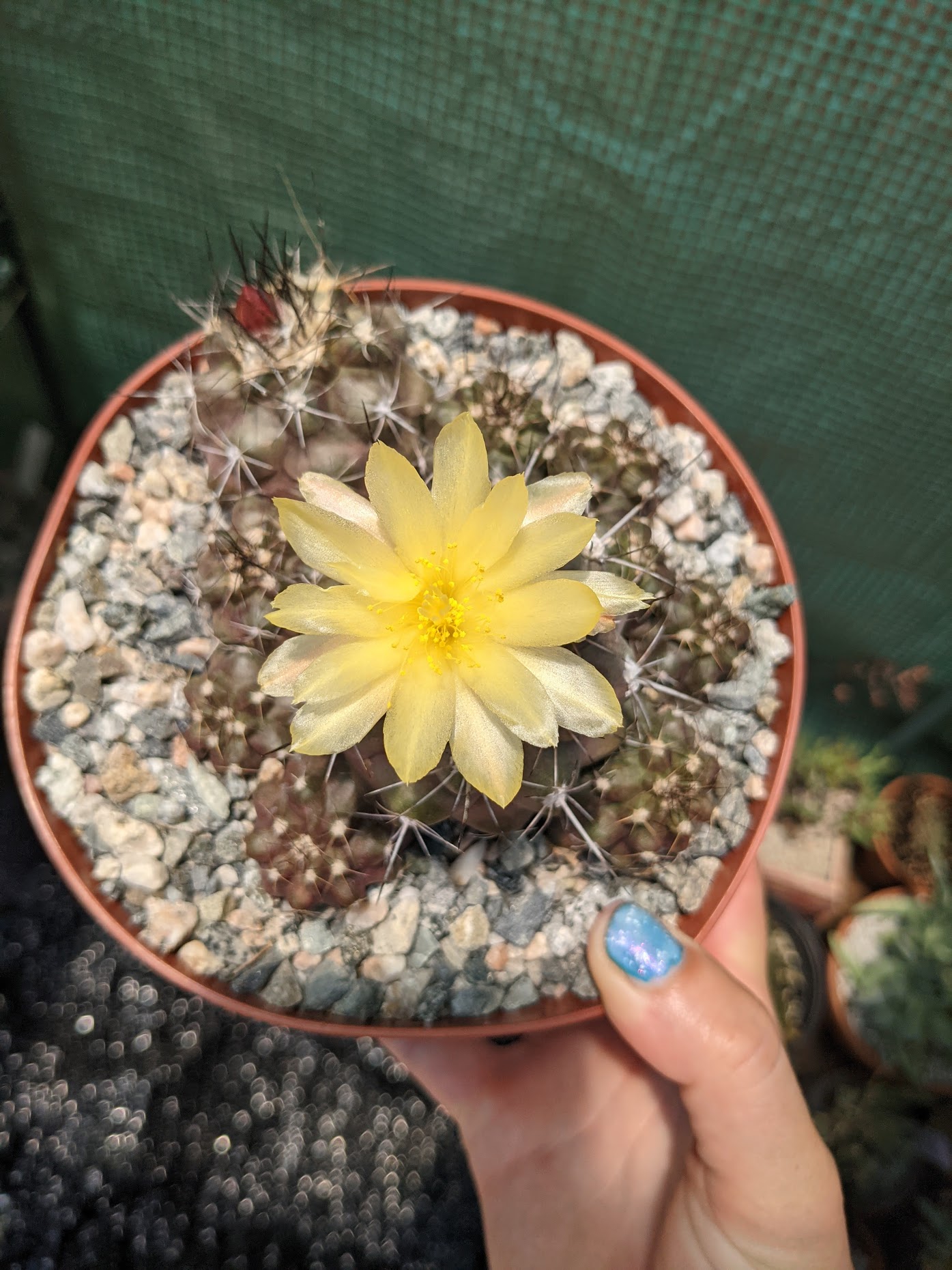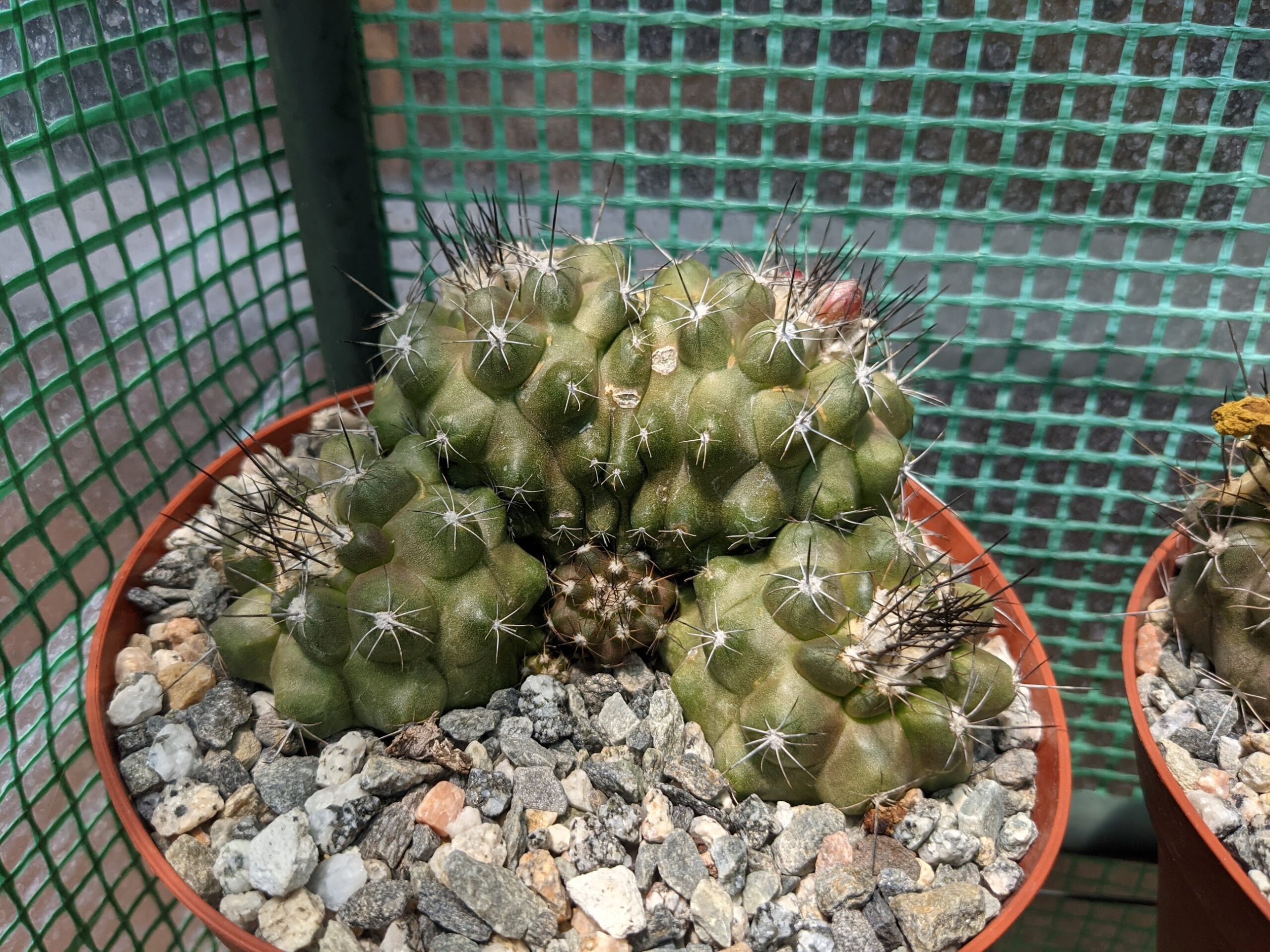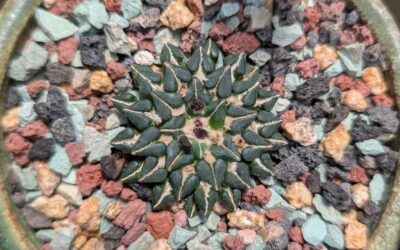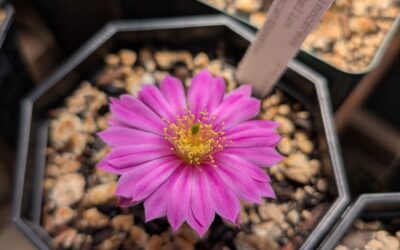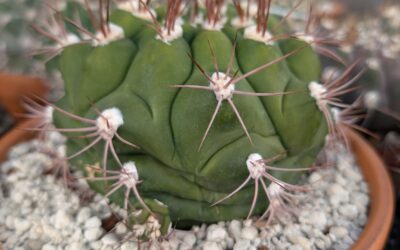Copiapoas!
I had never really paid much attention to this genus until I digitally met a gentleman who has one of the largest collections of them in the US – Mr. John Gilman. After reading an article where his collection was featured, and then googling multiple species…I was hooked.
I am still very much a novice Copiapoa keeper, and this genus is for the very, very patient grower, as they are slow growing to the extreme.
Today, I’ll be talking about one of the easiest and faster-growing species I have in my collection: Copiapa humilis – although whether mine are C. humilis ssp humilis or ssp varispina, I couldn’t say. My comments on appearance, origins, and care are based on reading Copiapoa 2006, by Rudolf Shulz.
Origins
Copiapoa humilis is, like all copiapoas, a species that originates on the western coast of Chile. C. humilis has a large range in terms of coastline, but somewhat narrow as far as depth inland – it is found mainly in the foggy elevations of the coastal mountains. You can find it a couple dozen kilometers north, and south, of the city of Paposo.
The valley that makes up the area this species is found in varies from north to south, with the northern end receiving more rainfall and fog than the southern end.
It is a small species, with a soft body and large taproot that extends down into the soil. They contract significantly during periods of drought, looking almost deflated, until the next rainfall. They do not form overly large clusters in the wild, often getting knocked around or eaten by donkeys or guanacos (an alpaca-like animal).
C. humilis ssp humilis appears to stay greener, even when stressed, while ssp varispina is noted as turning distinctly red with stress – which both of the cacti I have kept will show red stress coloration.
General Care
These are, frankly, some of the easiest cacti in my collection, as long as a handful of needs are met.
Soil
All copiapoa come from an area with very poor soil, with the most successful specimens often growing wedged between rocks where the local fauna has a harder time reaching them. As such, in cultivation, they do best when potted in a mix with very low organic material. I prefer to mix about 60 – 70% pumice with a high quality succulent and cactus soil. This keeps things from staying wet for too long, which is a near-immediate death sentence for this genus.
Water
In the wild, these cacti exist below the fog line of the mountains and hills they grow on, allowing them to collect some moisture from the early morning mist. They get very little measurable rain, and for C. humilis, the large tap root likely serves as a reservoir for water as well as a sturdy hold in the soil.
When growing in cultivation, they need to be kept extremely dry, particularly in winter. While most information available online or books tends to say these should stay warm over winter (between 40 and 50F), I have had little difficulties with these hitting 32 – 33F in winter. I keep them in a greenhouse, which ensures they stay dry even if it rains, and in the sheltered spot the greenhouse is in they never get below freezing or experience frost. With the greenhouse, this also meant their daytime temperatures would reach 70 – 80F occasionally, even in the middle of winter, so they did not stay at that low temperature.
I suspect the cold extreme tolerances are more related to how long they stay that cold (rarely more than 2 to 3 hours) and how warm they get after. The nature of where we live generally means that any nights that hit freezing have sunny days that follow, as cloud cover tends to trap warmth for us and leads to warmer nights. This means that when it’s super cold, we almost always have a sunny day after – which heats up the little plastic greenhouse enough to keep the cacti going. If you’re growing copiapoas in other climates, you’ll have to adapt for your area.
Humidity
Here in inland San Diego, relative humidity tends to be low. It’s an unusual day to have hot weather and humidity above 40%, and when we get Santa Ana wind events, humidity can drop to single digits.
For the copiapoas, this is great! They come from an exceedingly dry climate, and commonly get moisture from fog that burns off, very much like the morning marine layer we get locally.
However, in more humid climates, such as summers on the east coast, you may need to monitor your cacti more closely to ensure they are able to get appropriately dry. Using even less organic material in your soil mix, for example, can help if you’re in a very humid area.
Copiapoa humilis seems to be quite forgiving of nearly everything, however, so it works well as an introduction to the genus – even if you mess up, it’ll probably be just fine.
Fertilizer?
These are cacti that grow in extremely harsh, barren climates with little to no organic matter in their substrate, much less decomposing material that could be considered fertilizer.
So generally speaking, no, you don’t need to fertilize these. C. humilis will grow just fine in a sparse soil mix with infrequent but regular water during the growing season.
I may get some flak for this from die hard growers, but even though they don’t need fertilizer, I still feed them a dilute mix at the start of the growing season. When I see the first new spines starting to emerge, which is usually around the same time my lithops and mesembs are wrapping up their growing season, I’ll give both groups of plants a mild feed. The copiapoas don’t need much anyway, and I like to give the lithops a small boost as they finish absorbing their outer leaf bodies and head into dormancy.
It’s important to keep the feeding light! I reduce the amount to half of what’s recommended, and water lightly when I use it. At most, I’ll water with the fertilizer water until I just start to see water drip out of the bottom of the pot, and that’s generally it.
I will usually feed again at half-strength at the height of summer, when the plants are in the midst of their growth cycle.
Blooming
I find these to bloom readily and often starting in late spring and continuing through summer, particularly with regular water and a little cactus food.
The blooms are big, yellow, and supposedly scented, but I do not detect a smell on either of my plants when they bloom. They set seed readily, producing tiny fruits in a remarkably short time. Most of mine develop fruits within a month or so of the flowers closing, which is quite rapid compared to the various Notocactus species I have in my collection.
Fun fact: yellow blooms mean that these are typically pollinated by insects! In the case of copiapoa, their most common pollinators are beetles or hover flies, which are attracted to anything yellow.
Common Issues
If you look closely above, you can see some slight blemishes in the flesh of the copiapoa humilis pictured that is preparing to bloom. That’s not from overwatering – it’s from a chronic problem we have, which is rodents. Rats in particular seem to be fond of nibbling on cacti, and the two test bites on this one were from a rat that got into my mini greenhouse.
A brief word on rats
In my experience, the only way to deal with rats in your greenhouse or near your collection is to trap them, and I use the ones that kill. We have too many rodents and a very serious issue with them getting into our roof and attic, such that humane traps are not effective or desireable. Plus, in our area, there’s no humane place to release rodents – the brown rat is evolved to live in cities and human settlements, so relocating it somewhere remote is just as much of a death sentence as a snap trap. It’s just slower due to starvation or dehydration (and arguably less humane as a result).
Releasing trapped rodents, particularly rats, is also illegal in most places – this can introduce pests and disease in areas that did not have those problems before. If you’re caught and reported, it can be a significant fine for introducing a pest species into somewhere new! Additionally, if you’re letting rats go in a different neighborhood, you’re either moving your problem to those people (not cool) or putting the rat in a different family’s territory… in which case it will still die, just slowly, or from being beat up by other rats.
And if you’re releasing rats “just down the street”, be aware you haven’t really gotten rid of them. They can easily make it back a couple blocks from where you let them go.
If you want to humanely trap rats, trap them in a way that results in a quick demise. There is no ideal or humane way to trap and release them without causing harm in another way to a different ecosystem.
Pests
Pests on copiapoa humilis can include red spiders and/or mealybugs, with mealybugs being a more common concern in my area. Mealybugs are readily treated with common insecticide sprays, or just a q-tip with rubbing alcohol on it.
Red spiders are not a pest I have personally dealt with (yet) but seem easily managed with a blast of water or a quick rub of your finger or a q-tip.
Scale is also a potential pest, but one that is easily prevented or mitigated with a routine application of a systemic pesticide, such as what is commonly used for spider mites. Be sure to use only when the Copiapoa is not actively flowering to ensure no bees or beneficial pollinators end up consuming toxic nectar. Applying at the beginning of the growing season, in early spring, and at the end of growing season, in fall, is a good cadence to follow.
Copiapoa humilis, in cultivation, will eventually form a large clump of smaller cactus heads, something that doesn’t really occur in nature. Our care in captivity, even when providing the bare minimum these need to survive, tends to be better than their wild conditions, leading to larger plants that don’t always bear a resemblance to their cousins in nature.
The hardy nature of the species, small size (clumps can easily be managed by dividing the smaller heads), and large, showy blooms make these a rewarding Copiapoa that is well suited for the beginner to the genus.

